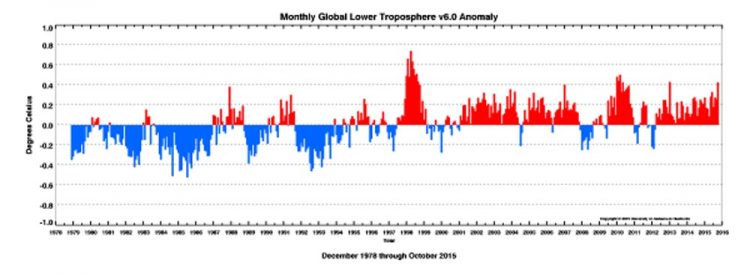Warmest October in the Satellite Temperature Record

<br><br>Warmest October in the Satellite Temperature Record UAH
Warmest October in the satellite temperature record
Global climate trend since Nov. 16, 1978: +0.11 C per decade
October temperatures (preliminary)
Global composite temp.: +0.43 C (about 0.77 degrees Fahrenheit) above 30-year average for October.
Northern Hemisphere: +0.64 C (about 1.15 degrees Fahrenheit) above 30-year average for October.
Southern Hemisphere: +0.21 C (about 0.38 degrees Fahrenheit) above 30-year average for October.
Tropics: +0.53 C (about 0.95 degrees Fahrenheit) above 30-year average for October.
September temperatures (revised):
Global Composite: +0.25 C above 30-year average
Northern Hemisphere: +0.34 C above 30-year average
Southern Hemisphere: +0.17 C above 30-year average
Tropics: +0.52 C above 30-year average
(All temperature anomalies are based on a 30-year average (1981-2010) for the month reported.)
Notes on data released Nov. 3, 2015:
Powered by an El Niño Pacific Ocean warming event, temperatures in October set records globally, in the Northern Hemisphere and the Tropics, while temperatures in the Southern Hemisphere pushed toward the upper end of the dataset, said Dr. John Christy, director of the Earth System Science Center at The University of Alabama in Huntsville. October 2015 was the warmest October in the 36-year satellite temperature record, pushing past October 1998 during what was then called the El Niño of the Century.
Warmest Octobers, Global
Date Warmer than seasonal norms
2015 +0.43 C
1998 +0.40 C
2003 +0.29 C
2005 +0.28 C
2014 +0.26 C
Warmest Octobers, Northern Hemisphere
Date Warmer than seasonal norms
2015 +0.64 C
1998 +0.48 C
2003 +0.46 C
2005 +0.35 C
2013 +0.33 C
Warmest Octobers, Tropics
Date Warmer than seasonal norms
2015 +0.53 C
1987 +0.40 C
1998 +0.37 C
2009 +0.34 C
2003 +0.33 C
In the Northern Hemisphere, October 2015 registered the third largest deviation from seasonal norms in the 443 month satellite temperature record, making it the third “warmest” month in the Northern Hemisphere since December 1978. October 2015 trailed only April 1998 (+0.85 C) and February 1998 (0.69 C) as the “warmest” month in the Northern Hemisphere.
“We thought this El Niño had the potential to be a record setter for some of the quantities we track, and it isn’t disappointing,” Christy said. “Not only is this a strong El Niño, but the transient warming we see from it is superimposed on top of the slowly rising global base temperature. The satellite temperature dataset shows an overall warming of about 0.39 C during the past 36 years. Put a strong El Niño on top of that and we shouldn’t be surprised at what we saw in October.”
Compared to seasonal norms, the warmest average temperature anomaly on Earth in October was over east Antarctica in Queen Maud Land. The October temperature there averaged 3.97 C (about 7.15 degrees F) warmer than seasonal norms. Compared to seasonal norms, the coolest average temperature on Earth in October was southwest of New Zealand on the edge of the southern ocean, where the average October 2015 temperature was 3.33 C (about 5.99 degrees F) cooler than normal.
The complete version 6 beta lower troposphere dataset is available here:
www.vortex.nsstc.uah.edu/data/msu/v6.0beta/tlt/uahncdc_lt_6.0beta3
Archived color maps of local temperature anomalies are available on-line at:
As part of an ongoing joint project between UAHuntsville, NOAA and NASA, Christy and Dr. Roy Spencer, an ESSC principal scientist, use data gathered by advanced microwave sounding units on NOAA and NASA satellites to get accurate temperature readings for almost all regions of the Earth. This includes remote desert, ocean and rain forest areas where reliable climate data are not otherwise available.
The satellite-based instruments measure the temperature of the atmosphere from the surface up to an altitude of about eight kilometers above sea level. Once the monthly temperature data is collected and processed, it is placed in a “public” computer file for immediate access by atmospheric scientists in the U.S. and abroad.
Neither Christy nor Spencer receives any research support or funding from oil, coal or industrial companies or organizations, or from any private or special interest groups. All of their climate research funding comes from federal and state grants or contracts.
Contact Information
Dr. John Christy, (256) 961-7763
john.christy@nsstc.uah.edu
Dr. Roy Spencer, (256) 961-7960
roy.spencer@nsstc.uah.edu
Media Contact
All latest news from the category: Earth Sciences
Earth Sciences (also referred to as Geosciences), which deals with basic issues surrounding our planet, plays a vital role in the area of energy and raw materials supply.
Earth Sciences comprises subjects such as geology, geography, geological informatics, paleontology, mineralogy, petrography, crystallography, geophysics, geodesy, glaciology, cartography, photogrammetry, meteorology and seismology, early-warning systems, earthquake research and polar research.
Newest articles

Ytterbium thin-disk lasers
… pave the way for sensitive detection of atmospheric pollutants. Alongside carbon dioxide, methane is a key driver of global warming. To detect and monitor the climate pollutants in the…

Selenium Carrier Proteins
New Starting Point for Cancer Research. A recent study from the University of Würzburg unveiled a key enzyme involved in producing selenoproteins, opening new strategies for treating certain types of…

Long-sought measurement of exotic beta decay in thallium
…helps extract the timescale of the Sun’s birth. Have you ever wondered how long it took our Sun to form in its stellar nursery? An international collaboration of scientists is…



